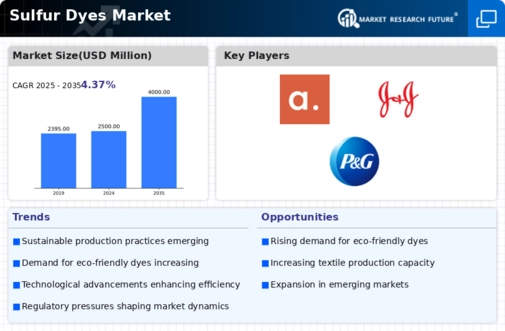Market Trends
Key Emerging Trends in the Sulfur Dyes Market
The Sulfur Dyes Market is currently experiencing notable trends that are influencing its dynamics across various industries. One significant trend is the increasing demand for sulfur dyes in the textile industry. These dyes are widely used for coloring cotton and other cellulosic fibers due to their cost-effectiveness and ability to produce vibrant and fast colors. The textile industry's emphasis on sustainable and environmentally friendly practices is driving the adoption of sulfur dyes, as they often require fewer chemicals and water during the dyeing process compared to other dye classes, aligning with the global push for eco-friendly textile manufacturing.
Environmental sustainability is a key driver influencing market trends in the Sulfur Dyes Market. With growing concerns about the environmental impact of chemical processes, there is a trend towards the development of eco-friendly and biodegradable sulfur dyes. Manufacturers are investing in research and development to create sulfur dyes that meet stringent environmental standards, reduce water consumption, and minimize the generation of hazardous waste. This trend reflects the industry's commitment to responsible and sustainable dyeing practices.
Technological advancements play a crucial role in shaping market trends in the Sulfur Dyes Market. Ongoing research efforts focus on improving the performance and versatility of sulfur dyes, including advancements in dyeing techniques and formulations. Innovations in dyeing machinery and processes contribute to enhancing the overall efficiency of sulfur dye applications in the textile industry. These technological trends cater to the evolving needs of textile manufacturers seeking cost-effective and sustainable dyeing solutions.
The denim industry is another significant influencer of market trends in the Sulfur Dyes Market. Sulfur dyes are commonly used in the production of denim due to their ability to create a variety of wash-down effects, contributing to the fashionable and distressed appearance of denim garments. As the demand for denim continues to grow globally, the Sulfur Dyes Market experiences increased demand from the denim manufacturing sector. This trend is driven by consumer preferences for unique and trendy denim products.
Supply chain dynamics and raw material costs are critical factors impacting market trends in the Sulfur Dyes Market. The availability and pricing of raw materials, such as sulfur, can influence the overall cost of sulfur dye production. Fluctuations in raw material prices, geopolitical factors, and supply chain disruptions can pose challenges for market participants. Companies in the Sulfur Dyes Market are implementing strategies to manage their supply chains effectively and ensure a stable and cost-effective production process.
Moreover, there is a growing trend towards regulatory compliance and certification in the Sulfur Dyes Market. As the awareness of environmental and health-related issues associated with textile dyeing processes increases, regulatory bodies and consumers are placing greater importance on certifications such as OEKO-TEX and GOTS (Global Organic Textile Standard). Manufacturers are adapting to these trends by ensuring that their sulfur dyes meet the required standards and environmental regulations, enhancing their market credibility and meeting the preferences of eco-conscious consumers.






Leave a Comment